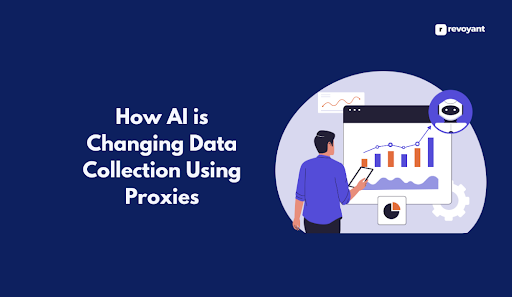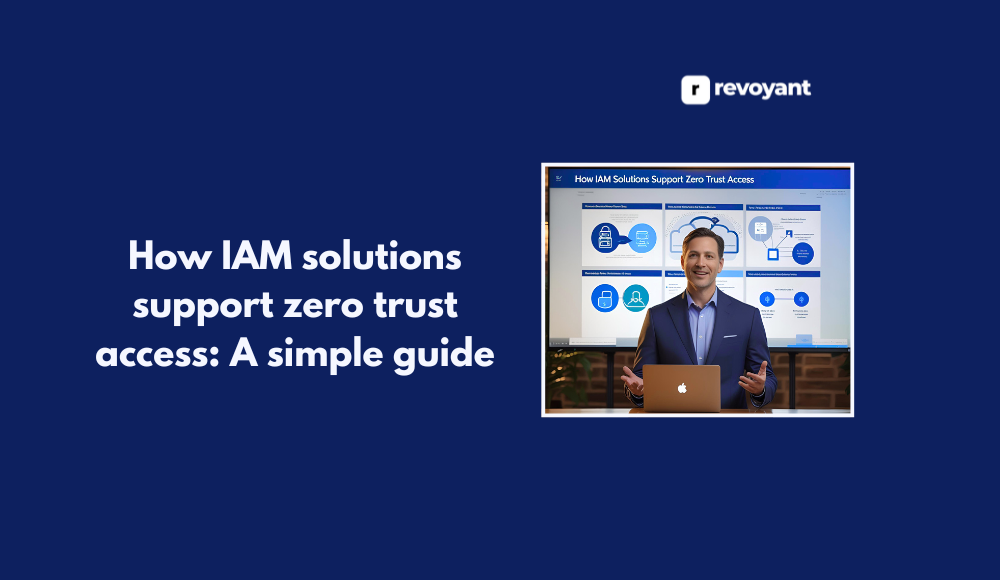In today’s world, AI chatbots are becoming more than just a cool trend—they’re practically a must-have for businesses. From providing instant customer support to automating routine tasks, chatbots can make your operations smoother and more efficient. But with so many options out there, how do you know which one is right for your business? Don’t worry! We’ve got your back with this friendly, easy-to-follow guide. We’ll walk you through everything you need to know to choose the best AI chatbot software for your needs.
📌 TL;DR Summary
Choosing the right AI chatbot software helps automate support, reduce response time, and deliver better customer experiences.
A full guide to chatbot types, must-have features like NLP and multi-channel support, pricing models, use cases, benefits, and latest trends.
Great for business owners, marketers, support teams, and product managers exploring tools to automate conversations and increase efficiency.
What is AI Chatbot Software and How Does It Work?
AI chatbot software is a tool that helps businesses simulate human-like conversations through chat interfaces. These bots can interact with users via websites, apps, or social platforms to handle tasks like answering common questions, guiding users through forms, or even managing appointments and purchases.
There are two primary types of chatbots:
- Rule-based bots operate on predefined scripts and decision trees. They’re ideal for handling straightforward interactions like FAQs or guiding users through a set path.
- AI-powered bots use technologies like NLP (Natural Language Processing) and ML (Machine Learning) to understand context, adapt to user inputs, and manage more nuanced conversations.
These bots work 24/7, don’t get tired, and can handle hundreds of interactions at once, making them a smart addition to any growing business.
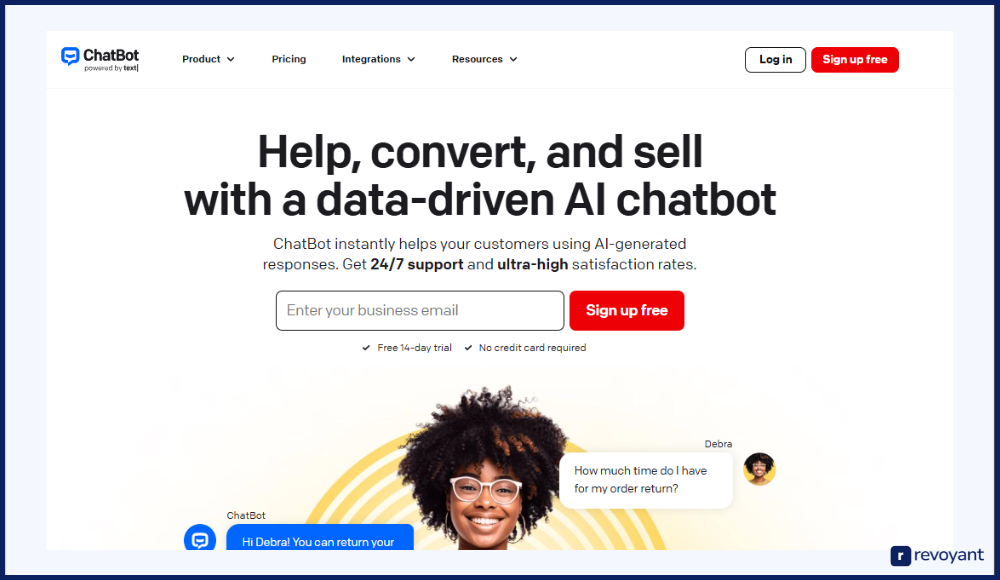
Top Features to Look for in AI Chatbot Software
When exploring chatbot platforms, it helps to know what features really matter. While each product might offer its own unique tools, the best AI chatbot software typically includes the following must-haves:
| Feature | What It Does | Why It Matters |
|---|---|---|
| Natural Language Processing (NLP) | Enables the bot to understand human language and intent, even when phrased differently. | Improves flow and makes conversations feel more natural and human-like. |
| Multi-Channel Support | Allows the chatbot to operate across websites, apps, social media, and messaging platforms. | Keeps your business accessible on your users’ preferred platforms. |
| Pre-Built Templates and Workflows | Comes with ready-made flows for tasks like support, booking, or lead capture. | Speeds up setup, especially for non-technical teams. |
| Integration with Other Tools | Connects with CRMs, e-commerce platforms, helpdesks, calendars, and email tools. | Keeps workflows efficient and allows for personalized automation. |
| Analytics and Reporting | Tracks bot performance like CSAT, drop-off points, and resolution time. | Gives you insights to continuously improve the bot’s effectiveness. |
| AI Learning Capabilities | Learns from user interactions to improve accuracy and adapt workflows automatically. | Makes the bot smarter over time and reduces manual updates. |
Natural Language Processing (NLP):
NLP is the technology that lets a chatbot understand and respond in human language. Instead of only recognizing exact keywords, NLP helps the bot grasp the intent behind what someone is saying. For example, whether a user types “Where’s my order?” or “Track my package,” an NLP-powered bot understands that both mean the same thing and responds accordingly.
Why it matters:
Without NLP, the chatbot feels robotic and rigid. With it, conversations flow more naturally, making users feel heard and understood.
Multi-Channel Support:
Customers don’t always stick to just one platform. That’s why modern chatbot software should work across multiple channels:
- Website chat widgets
- Mobile apps
- Facebook Messenger
- Slack, MS Teams, and more
Some platforms even offer SMS and email integration for follow-ups.
Why it matters:
Your audience may prefer different platforms. An AI chatbot software that works across them all helps ensure you’re always available, wherever they are.
Pre-Built Templates and Workflows:
Setting up an AI chatbot softwaret from scratch can be overwhelming. That’s why many tools come with pre-designed templates for popular use cases:
- Lead qualification
- Product recommendations
- Appointment booking
- Customer support FAQs
- Order tracking
These workflows can usually be customized to fit your brand and processes.
Why it matters:
Templates save time and make it easier for teams to launch their chatbot quickly, even with little or no technical knowledge.
Integration with Other Tools:
An AI chatbot software isn’t very useful if it doesn’t talk to the rest of your systems. That’s why seamless integration is key.
Look for chatbots that connect easily with:
- CRMs (like Salesforce, HubSpot, Zoho)
- E-commerce platforms (like Shopify, WooCommerce)
- Helpdesk software (like Zendesk, Freshdesk)
- Email marketing tools (like Mailchimp or Klaviyo)
- Calendars and booking tools (like Google Calendar, Calendly)
Why it matters:
Integrated bots can pull and push data automatically, enabling personalized responses, real-time updates, and smoother workflows.
Analytics and Reporting:
Knowing how your chatbot performs is just as important as setting it up. Most top-tier tools provide dashboards that show:
- Total conversations handled
- Drop-off points in chat flows
- Average response and resolution times
- User satisfaction scores (CSAT)
- Conversion rates
Some also offer heatmaps, chat transcripts, and performance by channel.
Why it matters:
Analytics help you understand what’s working and where improvements are needed, so your AI chatbot software keeps getting better over time.
AI Learning Capabilities:
Advanced bots don’t just follow scripts—they learn from every interaction. These bots use AI models to:
- Recognize new intents or phrasing
- Improve response accuracy
- Flag repeated user issues
- Adapt workflows based on past behaviors
Some platforms even let you train the bot by uploading past chat transcripts or customer data.
Why it matters:
The smarter your bot becomes, the less manual tweaking you’ll need. Over time, it can handle more queries, more efficiently.
Who Should Use AI Chatbot Software?
AI chatbot software isn’t limited to one industry or function. It’s widely used across departments and sectors to improve communication, automate repetitive tasks, and create a more responsive experience for both customers and employees. Here’s how different teams and industries put chatbots to work.
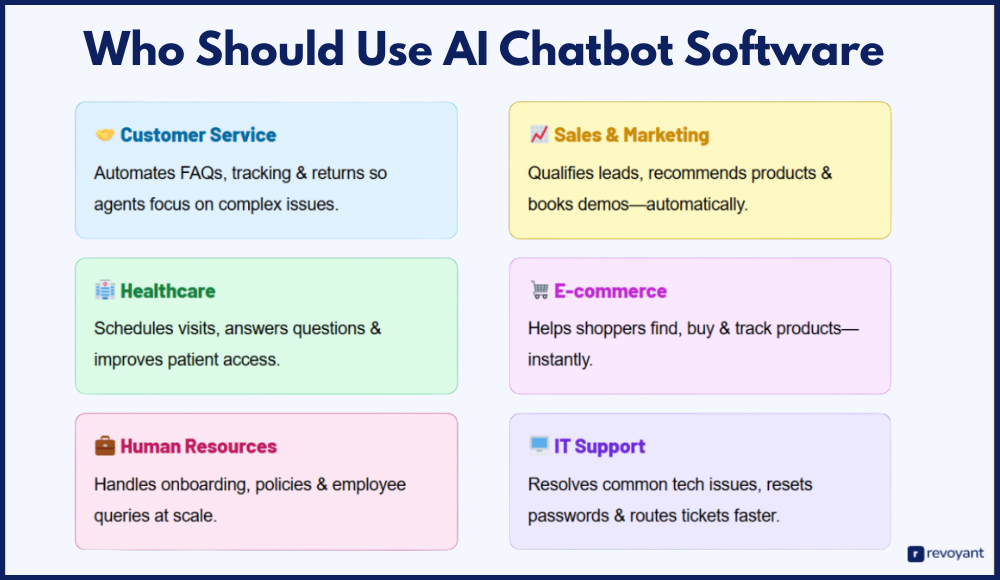
Customer Service Teams
Customer service is one of the most common use cases for AI chatbots. These bots help teams manage high volumes of support tickets by handling simple, repetitive queries like tracking orders, processing returns, or answering FAQs. By taking care of the routine, chatbots allow human agents to focus on complex or sensitive issues that require empathy or deeper expertise. This improves response times and ensures customers get help quickly, without long hold times or delays.
Sales and Marketing Teams
For sales and marketing professionals, AI chatbots act like digital assistants that work 24/7. They engage with website visitors in real time, qualify leads by asking pre-set questions, and even recommend products based on customer responses. Chatbots can also capture contact details, schedule demos, and send follow-up emails—automating parts of the funnel and boosting conversion rates without requiring constant manual input. This is especially helpful for businesses with high lead volume or short sales cycles.
Healthcare Providers
In the healthcare sector, AI chatbots are improving patient communication and reducing administrative load. Clinics and hospitals use them for tasks like scheduling appointments, reminding patients about upcoming visits, answering common questions, and collecting feedback. For patients, this means easier access to information and quicker service. For staff, it reduces time spent answering calls or managing calendars manually, freeing up resources for more critical needs.
E-commerce Businesses
E-commerce brands use chatbots to enhance the shopping experience from discovery to checkout. An AI chatbot software can guide users through product searches, suggest alternatives, check stock availability, apply discount codes, or offer support during the checkout process. After the purchase, it can help with order tracking or returns. By answering customer questions instantly, chatbots help reduce cart abandonment and improve overall satisfaction.
Human Resources Departments
In HR, chatbots assist with internal communication and employee support. They can help onboard new hires by walking them through the process, answering questions about benefits or leave policies, and even scheduling interviews or training sessions. For ongoing support, chatbots handle common inquiries like checking payroll details, requesting documents, or updating personal information. This reduces the volume of repetitive requests HR teams face and ensures employees get quick, consistent answers.
Key Benefits of AI Chatbot Software
AI chatbot software is more than just a tech upgrade—it’s a practical solution for improving efficiency, reducing costs, and creating better experiences for both customers and internal teams. Here’s a closer look at the key benefits businesses enjoy when they adopt chatbot technology.
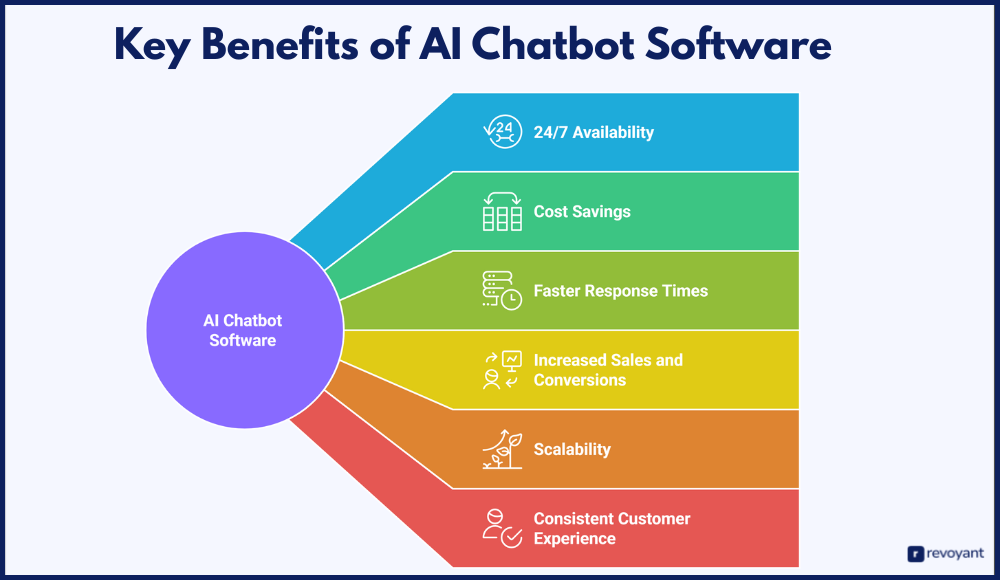
24/7 Availability
One of the biggest advantages of chatbots is that they never log off. They’re available around the clock, ready to assist customers no matter the time of day or their location. This means you’re not limited by office hours or time zones. Whether someone needs help at 2 p.m. or 2 a.m., the chatbot can respond immediately. For global businesses, this ensures consistent support without needing a full-time night shift team.
Cost Savings
Handling repetitive queries manually can get expensive, especially as your business grows. Chatbots help reduce that cost by automating tasks that would otherwise require multiple support agents. From answering FAQs to processing basic requests, chatbots reduce the burden on your team and allow you to operate more efficiently. Over time, this translates to fewer hires, lower training costs, and better use of your budget.
Faster Response Times
Today’s customers expect quick answers. Long wait times or slow replies can lead to frustration or lost sales. Chatbots eliminate delays by responding instantly, no matter how many people are asking questions at once. This quick turnaround not only keeps users happy but also reduces the pressure on human agents, who no longer need to rush through conversations to manage high volumes.
Increased Sales and Conversions
Chatbots can play an active role in your sales funnel. They greet website visitors, guide them to relevant products or services, and answer questions that might otherwise cause hesitation. By proactively offering help at key decision points—like on pricing pages or during checkout—chatbots can reduce friction and encourage users to complete a purchase. Some bots can even handle abandoned cart reminders or upsell suggestions, increasing your average order value.
Scalability
As your business grows, so does the number of customer interactions. Hiring and training new team members for every growth spurt isn’t always practical. Chatbots offer a scalable alternative. Whether you’re handling a few dozen chats a day or thousands during a big promotion, a AI chatbot software can manage the volume without sacrificing quality or response time. You won’t need to worry about being overwhelmed during peak seasons or viral campaigns.
Consistent Customer Experience
Human responses can vary depending on who’s answering and how busy they are. Chatbots, on the other hand, deliver the same response every time. This ensures that customers always receive accurate, brand-aligned answers to their questions. For businesses that care about maintaining a strong brand voice and reliable service quality, this consistency is a major advantage.
Common Challenges When Using AI Chatbot Software
While AI chatbots offer plenty of advantages, they’re not without their limitations. Understanding these challenges ahead of time can help you plan better, set realistic expectations, and choose a solution that aligns with your business needs.
| ⚠️ Challenge | Summary |
|---|---|
| Complex Queries | Struggles with unclear or emotional questions unless heavily trained. |
| Integration Gaps | Disconnected systems reduce workflow efficiency and data sync. |
| Setup Time | Advanced setup often requires developer time and testing. |
| User Frustration | Loops, misreads, or lack of human handoff can annoy users. |
| Language Limits | Many bots lack strong multilingual or dialect support. |
Limited Understanding of Complex Queries
Despite advancements in artificial intelligence, chatbots still face difficulty when handling vague, multi-layered, or emotionally charged questions. For example, a bot may easily answer “What’s your return policy?” but might get confused by “I ordered something two weeks ago and it’s not here yet—what’s going on?” unless it’s trained on specific use cases. Without clear context or structured input, even intelligent bots can provide generic or irrelevant responses. This becomes more noticeable in industries where users expect nuanced, detailed answers.
Integration Issues
A chatbot is only as useful as its ability to work with your existing systems. If it doesn’t connect smoothly with your CRM, helpdesk, e-commerce platform, or booking system, you may run into data gaps, duplicate entries, or workflow bottlenecks. For instance, a bot that can’t access your order database won’t be able to update customers on their shipping status. Integration challenges can lead to additional manual work and reduce the overall value the chatbot is supposed to bring.
Setup and Customization Time
Getting an AI chatbot software up and running might seem quick at first—especially with pre-built templates—but configuring it to meet your specific needs can take time. If you want to build a truly conversational experience, add unique workflows, or integrate it with multiple tools, you may need developer support or technical training. Businesses without in-house resources may find the process more time-consuming or require external help, which adds to the cost and complexity.
Risk of Frustrating Users
A chatbot that gets stuck in loops, misunderstands questions, or refuses to connect users with a live agent can quickly create frustration. Customers may feel ignored or trapped in a conversation that’s going nowhere. This can damage trust and increase the chance of losing a sale or getting negative feedback. It’s important to ensure your chatbot has a clear fallback option—like offering the option to talk to a human—when it can’t handle a request.
Language Limitations
Many AI chatbot software support only a handful of languages, and even fewer handle regional dialects, slang, or multilingual conversations with fluency. If your customer base is spread across different countries, this can limit your ability to serve them effectively. A bot that works well in English may struggle to deliver the same quality of service in Spanish, Arabic, or Hindi. This becomes a real concern for global businesses or those expanding into new markets.
Best Alternatives to AI Chatbot Software
AI chatbot software isn’t always the perfect fit for every business or use case. Depending on your goals, audience, or available resources, there may be other tools that offer a better solution. Here are a few alternatives worth considering.
| 🧩 Feature | 💬 Live Chat | 🔀 Hybrid Chat | 🎙️ Voice Assistants |
|---|---|---|---|
| Real-time Human Support | ✅ | ✅ | ❌ |
| Automation Support | ❌ | ✅ | ✅ |
| Hands-Free Interaction | ❌ | ❌ | ✅ |
| Empathy & Personalization | ✅ | ✅ | ⚠️ |
| Requires Human Staffing | ✅ | ✅ | ❌ |
Live Chat Software
Live chat tools allow users to connect directly with a human agent in real time. Instead of automated responses, customers interact with someone who can fully understand and respond to their unique questions or concerns. This approach is ideal for businesses that prioritize personal engagement, especially in industries where customers often ask complex or sensitive questions—like healthcare, legal services, or high-end retail.
Live chat can also be more effective in scenarios where empathy and human judgment are needed. While it requires staffing and can’t operate around the clock without shifts, it provides a level of personalization that AI alone may not match.
Hybrid Chat Solutions
Hybrid systems blend the efficiency of chatbots with the flexibility of live human support. In this setup, a chatbot handles routine questions and simple tasks—such as answering FAQs, booking appointments, or collecting contact information. When a user asks something beyond the bot’s scope, the conversation is seamlessly handed over to a live agent.
This model offers the best of both worlds: the speed and scalability of automation with the nuance and problem-solving ability of a real person. It’s a great fit for companies that want to improve customer response times while still delivering high-quality service.
Voice Assistants
If your target audience prefers speaking over typing, voice-enabled assistants might be a better fit. These tools use speech recognition and natural language processing to allow users to interact using voice commands. Platforms like Amazon Alexa, Google Assistant, and Apple’s Siri are already widely used and can be integrated into apps, websites, or devices.
Voice assistants are especially useful for hands-free interactions—like in smart homes, cars, or healthcare settings. For example, a voice assistant can help users check their schedule, reorder a product, or ask for instructions—all without touching a screen.
AI Chatbot Software Pricing: What to Expect
AI chatbot software is available at a wide range of price points, depending on your business size, feature requirements, and level of customization. Whether you’re a startup testing your first chatbot or an enterprise looking for a fully integrated AI assistant, your total cost will be influenced by a few key factors.
Basic Plan
💲 $50–$100/month
👥 1–3 Users
💬 Chat Widget
🧠 NLP Enabled
🔗 Basic Integrations
Pro Plan
💲 $150–$500/month
👥 Up to 10 Users
📊 Advanced Analytics
🤖 AI Training
🔗 CRM + E-com Integration
Enterprise Plan
💲 $500+/month
👥 Unlimited Users
🧩 Full API Access
📞 Premium Support
⚙️ Custom Workflows
Custom Build
💲 Varies by Scope
👨💻 Full Dev Team Needed
🔐 On-Premise or Cloud
🛠️ Highly Tailored Flows
🚀 Long-Term Scalability
Subscription Model
Most AI chatbot software follow a subscription-based pricing model. This typically involves a monthly or annual fee, with the cost scaling based on usage levels, number of team members, or the feature set you choose. For smaller businesses or teams just getting started, plans may begin around $50 to $100 per month. More advanced packages—with higher chat limits, multiple user seats, or premium features like AI learning, integrations, or multi-channel support—can go upwards of $500 per month or more.
Some platforms offer tiered pricing, which allows you to upgrade as your needs grow. Others provide modular pricing, where you pay for only the features you use.
Customization Fees
If your business needs a AI chatbot software with highly specific workflows, branding, or third-party integrations, there may be additional costs for customization. This could include creating unique conversation flows, designing a custom UI, connecting with in-house tools, or tailoring responses to align with your brand voice.
While some platforms offer these services in-house, others may require working with external developers or certified partners, which can increase the overall cost. For businesses that need a heavily branded or specialized experience, customization is often a necessary investment.
Usage-Based Pricing
Instead of charging a flat rate, some AI chatbot softwares use a pay-as-you-go or usage-based model. This means you’re billed based on the number of conversations, messages exchanged, or sessions handled each month. These plans are particularly appealing to businesses with fluctuating traffic or seasonal spikes, as they allow you to scale costs based on actual demand.
For example, if your website sees a surge in customer inquiries during holiday seasons, your AI chatbot software plan adjusts accordingly. This flexibility helps control costs during slower periods while still supporting growth during peak times.
Support and Maintenance Costs
While many platforms offer basic support as part of their pricing, ongoing premium support—such as dedicated account managers, priority issue resolution, or onboarding assistance—may come at an extra charge. Some businesses also opt for regular chatbot reviews and optimization services to keep performance high and error rates low.
These additional services can range from a few hundred to several thousand dollars annually, depending on the provider and service level agreement (SLA).
Development Costs
If your company chooses to build a AI chatbot software from the ground up or make heavy customizations to an open-source platform, be prepared for a more significant upfront investment. Development costs can include hiring engineers, user experience designers, and QA testers to build, test, and deploy the AI chatbot software.
This route is often taken by enterprises with very specific needs or security requirements. While the long-term control and flexibility can be beneficial, the initial costs are usually much higher than using a pre-built SaaS solution.
How to Choose the Best AI Chatbot Software
With so many AI chatbot software tools on the market, making the right choice can feel overwhelming. But if you take a structured approach, the process becomes much more manageable. Here’s a step-by-step breakdown to guide your decision.
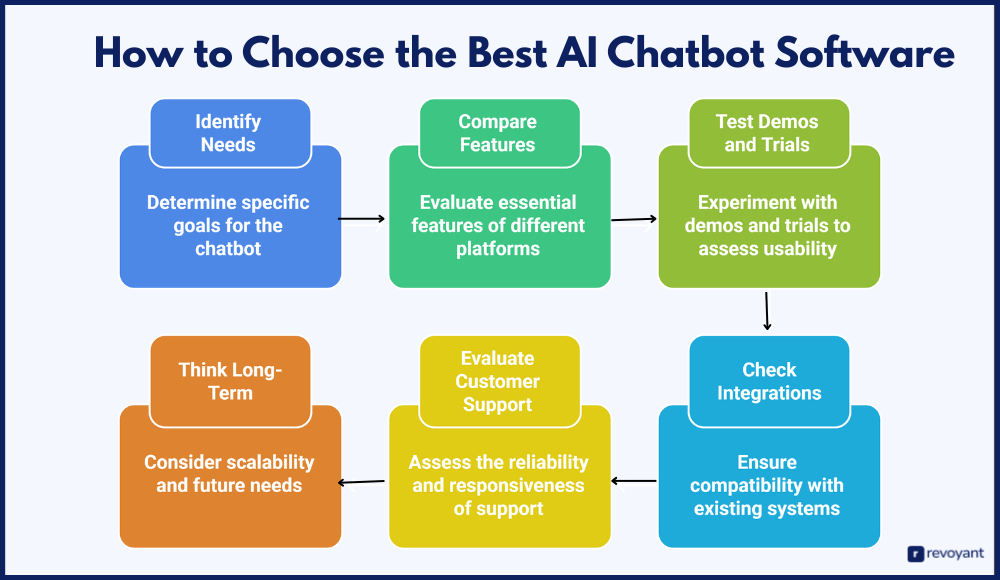
Identify Your Needs
Before diving into features and pricing, start with a clear understanding of what you want the AI chatbot software to accomplish. Are you looking to reduce customer support workload? Generate and qualify leads? Automate internal HR or IT tasks? The more specific you are about your goals, the easier it becomes to narrow your options. For example, a bot built for e-commerce sales might not be the best fit for a healthcare provider handling appointment scheduling.
Knowing your use case helps you focus on tools designed for your exact needs rather than getting distracted by unnecessary features.
Compare Features
Once your goals are defined, list out the core features that are essential for your AI chatbot software. This might include things like natural language processing, multi-language support, pre-built templates, or CRM integration. Use this list as a reference to compare different platforms side by side. Don’t just rely on marketing claims—dig into how each feature actually works and how flexible it is for your business setup.
Also, consider the user interface and dashboard experience. A powerful AI chatbot software with a clunky interface can still slow your team down.
Test Demos and Free Trials
Most top-tier AI chatbot softwares offer either live demos, interactive sandboxes, or free trial periods. These are valuable opportunities to see the tool in action. During the trial, test common user flows, experiment with different question types, and explore the backend settings to evaluate ease of use.
If possible, simulate real customer scenarios to assess how the bot performs in your business context. A few hours spent testing can save weeks of frustration later.
Check for Integrations
Even the smartest AI chatbot software won’t deliver results if it can’t work with your existing systems. Whether you use HubSpot, Shopify, Zendesk, or another platform, make sure the chatbot integrates with them smoothly. Look for native integrations first, as they tend to be easier to set up and maintain. If those aren’t available, check if the platform offers APIs or connects via middleware tools like Zapier or Make.
A good integration setup ensures data flows correctly between systems, enabling better personalization, automation, and reporting.
Evaluate Customer Support
Reliable support is essential—especially during setup and early adoption. Check what kind of assistance the provider offers. Is there a live chat option, knowledge base, or dedicated account manager? Are training resources available to help your team onboard quickly? Read user reviews and ratings to understand how responsive the company is when problems arise.
Strong customer support can make the difference between a smooth rollout and a frustrating experience.
Think Long-Term
Finally, choose AI chatbot software that won’t hold you back as your business evolves. Look at scalability options, such as user or conversation limits, and check if the provider regularly updates its platform with new features. Also consider whether you’ll need advanced capabilities like multilingual support, voice assistance, or AI learning down the line.
Choosing software that can grow with you ensures you won’t need to switch platforms just a year or two later.
Tips for a Smooth Implementation
Getting your AI chatbot up and running isn’t just about switching it on. A thoughtful rollout plan can make the difference between a tool that adds value and one that causes confusion. Here are some practical tips to help ensure a successful implementation.
Create Clear Goals
Start by defining what success looks like for your chatbot. Are you aiming to reduce average response times? Increase qualified leads? Cut down on repetitive tickets for your support team? Having clear goals not only helps guide the initial setup but also gives you a benchmark to measure performance. It’s easier to adjust and improve your AI chatbot software when you know exactly what you’re trying to achieve.
Involve Your Team
Don’t build your chatbot in a vacuum. Involve the teams that will actually use it—such as customer support, sales, or HR. These teams know the types of questions they get every day and can provide valuable insight into what the AI chatbot softwareshould handle. Their feedback during setup ensures the bot feels helpful rather than robotic or irrelevant. Plus, when your team is part of the process, they’re more likely to support and adopt the tool.
Train Your Employees
Once the bot is live, your job isn’t done. Your employees need to understand how the AI chatbot software works, how to monitor conversations, and when to step in. Training your team on how to review chatbot logs, make updates to flows, and handle handoffs to human agents will keep the system running smoothly. The better your team understands the tool, the more confident they’ll feel using and maintaining it.
Start with a Pilot Test
Before rolling out the AI chatbot software to your entire audience, test it in a smaller, controlled environment. This could be a specific customer segment or even internal staff. Use this test phase to gather feedback, identify any gaps in your workflows, and iron out bugs. A pilot run gives you the chance to make improvements without risking a negative experience for your entire user base.
Monitor and Optimize
After launch, keep a close eye on how the chatbot performs. Use built-in analytics to track key metrics such as response accuracy, drop-off rates, user satisfaction, and time saved. Look for patterns in what users are asking and adjust your workflows accordingly. Optimization isn’t a one-time task—it’s an ongoing process that keeps your AI chatbot software relevant and effective over time.
Latest Trends in AI Chatbot Software
The AI chatbot software space is advancing quickly, with new capabilities being added every year. What started as simple rule-based bots has evolved into intelligent systems that understand nuance, context, and even emotions. If you’re planning to invest in AI chatbot software, it helps to stay updated on the latest trends shaping the future of these tools.
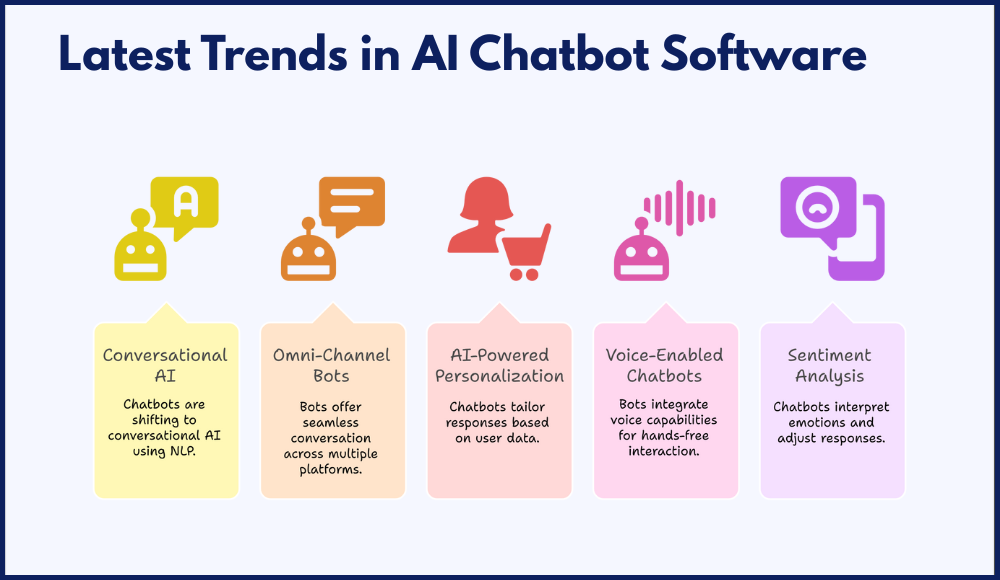
Conversational AI
One of the biggest advancements in chatbot technology is the shift from scripted responses to truly conversational AI. These next-generation bots use advanced Natural Language Processing and deep learning to understand context, interpret intent, and carry on human-like conversations. Instead of rigid interactions, users experience more fluid, two-way dialogue. This makes the AI chatbot software feel more like a real assistant rather than a FAQ machine.
As conversational AI continues to improve, expect chatbots to handle more open-ended queries, switch between topics smoothly, and even follow up based on previous interactions.
Omni-Channel Bots
Modern users don’t stick to one platform—and neither should your chatbot. Omni-channel bots are designed to offer a seamless conversation experience across websites, mobile apps, email, social platforms like Facebook and Instagram, and messaging services like WhatsApp or Slack. These bots can pick up a conversation exactly where the user left off, regardless of the platform.
This level of consistency helps build trust and ensures users don’t have to repeat themselves if they switch devices or communication channels.
AI-Powered Personalization
Chatbots are becoming smarter at tailoring their responses based on user behavior, preferences, and past interactions. By tapping into customer data—such as purchase history, location, or engagement patterns—bots can deliver personalized recommendations, reminders, and support.
For instance, a returning customer might be greeted by name, shown similar products to past purchases, or reminded about items left in their cart. This kind of personalization boosts engagement and makes the interaction feel more relevant and helpful.
Voice-Enabled Chatbots
With the growing popularity of voice assistants like Alexa, Siri, and Google Assistant, more businesses are integrating voice capabilities into their chatbots. Voice-enabled bots allow users to interact without typing, making them ideal for hands-free environments like driving, working out, or multitasking at home.
These bots combine voice recognition with AI to understand spoken commands and respond naturally, opening up new use cases across industries—from healthcare and hospitality to e-commerce and education.
Sentiment Analysis
Today’s chatbots don’t just understand words—they’re learning to interpret emotions. Through sentiment analysis, AI can detect whether a user is feeling frustrated, confused, or happy based on tone, language, and interaction patterns. The AI chatbot software can then adjust its responses accordingly.
For example, if a customer expresses dissatisfaction, the bot might prioritize connecting them to a live agent or use a more empathetic tone. This emotional awareness adds a human touch to automated interactions and helps improve the overall user experience.
Final Thoughts
Choosing the best AI chatbot software doesn’t have to be overwhelming. With a clear understanding of your business goals, the right set of features, and a step-by-step evaluation process, you can find a solution that fits both your immediate needs and future growth.
Whether you’re aiming to streamline customer support, boost lead generation, or improve internal communication, today’s AI chatbots offer powerful tools to help you work smarter. Just remember: the most effective chatbot isn’t the one with the most features—it’s the one that fits seamlessly into your workflow and consistently delivers value to your users.
Take the time to explore, test, and optimize. A well-chosen AI chatbot software can do far more than answer questions—it can elevate your customer experience, strengthen engagement, and support your team around the clock.
Frequently Asked Questions
1. What’s the difference between rule-based and AI-powered chatbots?
Rule-based chatbots follow predefined scripts and decision trees, making them ideal for handling simple, repetitive tasks. AI-powered chatbots use Natural Language Processing (NLP) and machine learning to understand context, learn from interactions, and manage more complex or varied conversations.
2. Can AI chatbots replace human agents?
AI chatbots are great for handling routine queries and reducing workload, but they aren’t meant to fully replace human agents. The most effective setups use a hybrid model—where bots handle basic tasks and seamlessly hand off more complex issues to a live agent when needed.
3. Do I need coding skills to set up a chatbot?
Not necessarily. Many AI chatbot software offer no-code or low-code builders with drag-and-drop interfaces. These make it easy for non-technical users to create conversation flows and deploy bots without writing a single line of code.
4. How secure is AI chatbot software?
Reputable chatbot platforms prioritize security with features like data encryption, user authentication, and compliance with regulations such as GDPR or HIPAA (depending on your industry). Always review a vendor’s security documentation before choosing a platform.
5. How long does it take to implement an AI chatbot?
Implementation time varies based on complexity. A simple chatbot with pre-built templates can be up and running within a few hours. More customized bots with deep integrations or advanced features may take a few weeks to fully configure and test.


